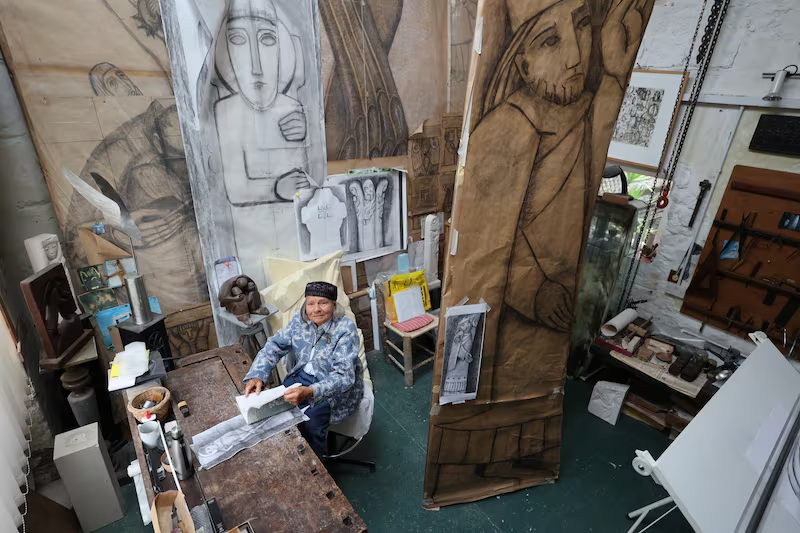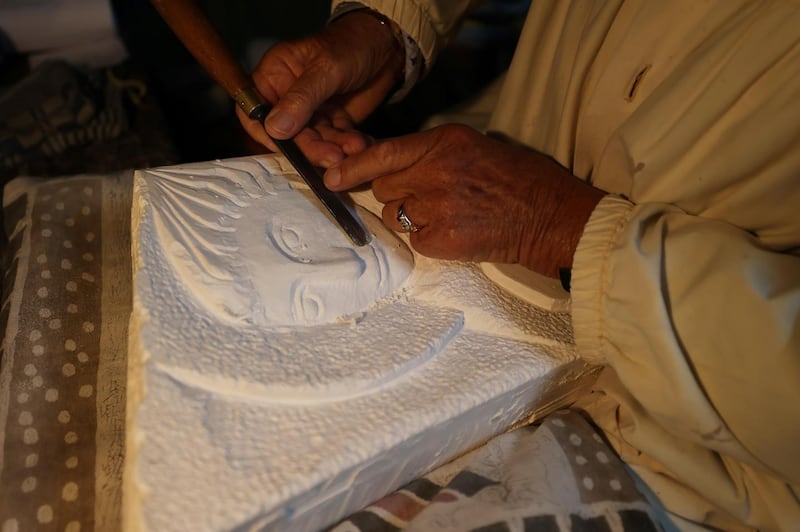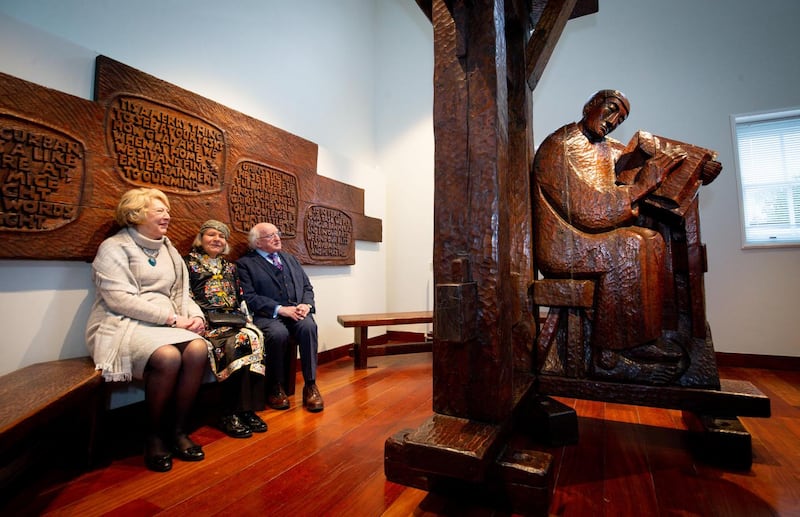There are many beautiful pieces of sculpture, drawings, carvings and other artworks in sculptor Imogen Stuart’s living room, but my eye is drawn to what’s in the open box on the mantelpiece.
It’s possible to put a price on all the other artefacts in the room, but not this piece. It will never be for sale, and Stuart did not buy it.
It's the gold torc that marked her ascension to Saoi in 2015. It was formerly held, in turn, by Sean O'Faolain, Benedict Kiely, and Patrick Scott. Stuart, like her predecessors in literature and visual art, was honoured with this torc to acknowledge the immense contribution she had made to the arts in Ireland.
“Yes, of course,” she says, when I ask if I can pick it up. It’s a thrilling moment, connecting with artists both past and present.

Imogen Stuart, who was born in Berlin, is now 94. Although she has lived in Ireland for decades, her German accent remains as much part of her speaking voice as the grain of the different woods she loves to carve, particularly teak.
“I love teak and other hardwoods. I always compare wood with horses because you have to understand them both. And if you understand them, they are very willing, as long as you are not rough with them.”
Stuart was born in Berlin in 1927, where she studied sculpture. With the ascension to power of the Nazi Party, her family left Germany, returning after the end of the war. In 1948, she met Ian Stuart, also a sculptor. Stuart was the son of Iseult Gonne, and grandson of Maud Gonne MacBride. They married in 1951, and moved to Ireland.
"We lived in Laragh Castle near Glendalough, " she says, downplaying the grandeur of the address by describing it as "damp", while adding casually that her daughters had their bedroom in "the tower room".
Death is so near me now. I will miss music, but I don't really like thinking about death. I don't like to think to much about an afterlife, but I hope there is one
Her mother-in-law, Iseult Gonne, lived with them in the grand, damp castle, and Maud Gonne MacBride also visited. “She had a very dramatic voice,” Stuart says.
Both these women had been courted by WB Yeats, who wrote many poems inspired by Maud Gonne.
Did Stuart ever meet Yeats?
“I never met him. I only heard talk about him,” she says.
Her husband, Maude Gonne’s grandson, read aloud to her the poems Yeats had written about his grandmother. Given the long association of the arts with the family, did Maud Gonne show interest in the sculptures that Stuart was now making?
“No,” is the very short answer.
Imogen Stuart has lived in her Sandycove home since 1962, from where she has continued to make her art over the decades. Her distinctive work is blocky and angular in shape. A secular piece which Dubliners will be familiar with is the Fiddler of Dooney and the dancing children at the Stillorgan shopping centre.
Much of her best known-known work was commissioned for churches, or places with a Catholic ethos. The angel over Clarendon Street Church is hers. So too are the Stations of the Cross at Ballintuber Abbey, Co Mayo; and also at the Liam McCormick-designed church in Milford, Co Donegal; the baptismal font at the Honan Chapel in UCC, and several other locations.

Stuart doesn't carve anymore, but she continues to design her sculptures in a nearby studio, and still receives commissions. These include an upcoming one from the Abbess of Kylemore Abbey for the grounds of the former industrial school at Letterfrack in Connemara.
So much of her work has been for churches or religious-themed institutions in Ireland. Does it distress her that the numbers of people attending these places has fallen so sharply, thus meaning the visibility of her art has also declined?
“I think in the country, they do still go to these places,” she answers.
Over the course of the couple of hours I spent in her Sandycove home, I realise that talking with Stuart is a bit like chasing after a rainbow. She is elusive. It gradually becomes clear: she loves to talk, but not to be interviewed. She answers one question in maybe four. The others are artfully deflected, with a smile.
Here’s an example.
The tortoise. There must be about 40 of them of all sizes and materials, arranged on a table in front of us, and scattered through the room, Stuart is wearing an enamel brooch that depicts a trio of them.
“Does the tortoise have a particular meaning for you?”
“They took over in my life.”
“How did that happen?”
“People say they see the shape of the tortoise in my work.”

She gestures to a model of the large bronze sculpture that is on display in the Maynooth University campus in one corner of the room. I depicts the Pope John Paul II leaning over two children, arms extended downwards. It indeed looks uncannily like a giant carapace.
“The Pope is like a tortoise. A bridge builder.”
“Was the tortoise shape intentional then?’
“Oh, no,” Stuart laughs. “I never know how things are going to turn out until they are finished.”
So I am really no clearer about the significance or not of the many, many tortoises in the room.
Stuart had three daughters with her husband, Aoibheann, Siobhan and Aisling. They divorced in 1973, after having separated for many years: the divorce was formalised in England. In 1988, their daughter Siobhan died in a car crash, aged just 30, leaving small sons behind. "My work was like a sanctuary after she died," Stuart says, talking about how she coped with the tragedy. "It was so important."
Given that so much of her work has been for Catholic institutions, what are Imogen Stuart’s beliefs on a possible afterlife after death?
“Death is so near me now,” she says, matter-of-factly. “I will miss music, but I don’t really like thinking about death. I don’t like to think too much about an afterlife, but I hope there is one, because of all those wonderful people who died. They can’t be all gone. Can they?”



















